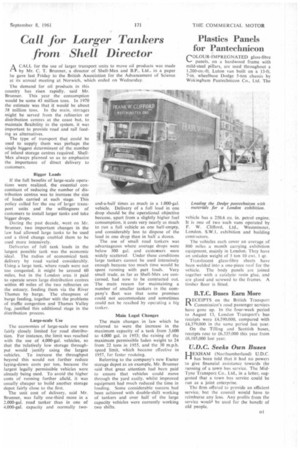Call fir Larger Tankers from Shell Director
Page 65

If you've noticed an error in this article please click here to report it so we can fix it.
A CALL for the use of larger transport units to move oil products was made rA by Mr. C. T. Brunner, a director of Shell-Mex and B.P. Ltd.. in a paper he gave last Friday to the British Association for the Advancement of Science at its annual meeting at Norwich, which ended on Wednesday.
The demand for oil products in this country has risen rapidly. said Mr. Brunner. This year the consumption would be some 43 million tons. In 1970 the estimate was that it would be about 58 million tons. In the main. storages might be served from the refineries or distribution centres at the coast but, to maintain flexibility in the system, it was important to provide road and rail feeding as alternatives.
The type of transport that could be used to supply them was perhaps the single biggest determinant of the number of inland storage centres required. ShellMex always planned so as to emphasize the importance of direct delivery to customers.
Bigger Loads
If the full benefits of large-scale operations were realized, the essential concomitant of reducing the number of distribution centres was to increase the size of loads carried at each stage. This policy called for the use of larger transport units and the willingness of customers to install larger tanks and take bigger drops.
During the past decade, went on Mr. Brunner, two important changes in the law had allowed large tanks to be used and a third change enabled them to be used more intensively. Deliveries of full tank loads in the largest possible tank was the economic ideal. The radius of economical tank delivery by road varied considerably. Using a large tank, where roads were not too congested, it might be around 60 miles, but in the London area it paid to operate seven large distribution centres within 40 miles of the two refineries on the estuary. feeding them via the River Thames by barge. The cheapness of barge feeding, together with the problems of traffic congestion and Thames Valley fog, justified this additional stage in the distribution process.
Large-scale Use
The economies of large-scale use were fairly closely limited for road distribution. For instance, the limit was reached with the use of 4,000-gal. vehicles, so that the relatively low storage throughput would justify using the largest vehicles. To increase the throughput beyond this would not further reduce laying-down costs per ton, because the largest legally permissible vehicles were already being used. To avoid the higher costs of running further afield, it was usually cheaper to build another storage depot fairly close to the first. The unit cost of delivery, said Mr. Brunner, was fully one-third more in a 2.000-gal. road tanker than in one of 4,000-gal. capacity and normally two and-a-half times as much in a 1.000-gal. vehicle. Delivery of a full load in one drop should be the operational objective because, apart from a slightly higher fuel consumption. it costs very nearly as much to run a full vehicle as one half-empty, and considerably less to dispose of the load in one drop than in half a dozen. The use of small road tankers was advantageous where average drops were below 500 gal. and customers were widely scattered. Under these conditions large tankers cannot be used intensively enough because too much time would be spent running with part loads. Very small trade. as far as Shell-Mex are concerned, had now to be contracted out. The main reason for maintaining a number of smaller tankers in the company's fleet was that some premises could not accommodate and sometimes could not be reached by operating a big tanker.
Main Legal Changes
The main changes in law which he referred to were the increase in the maximum capacity of a tank from 3,600 to 4.000 gal. in 1953; the raising of the maximum permissible laden weight to 24 from 22 tons in 1955. and the 30 m.p.h. speed limit, which became effective in 1957, for faster routeing. Referring to the company's new Exeter storage depot as an example, Mr. Brunner said that great attention had been paid to ensure that vehicles could move through the yard easily. whilst improved equipment had much reduced the time in loading. Some considerable success had been achieved with double-shift working of tankers and over half of the large capacity vehicles were currently working two shifts.


































































































































































